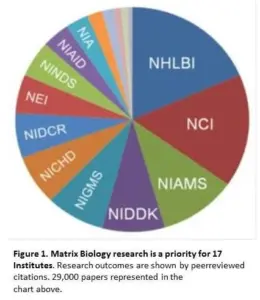
Matrix Biology is about understanding the support structure that holds our body’s cells together. This structure is very important for our blood vessels, organs, skin, and all the tissues in our body.
COBRE in Matrix Biology Specific Aims
Biomedical research is a high priority for Boise State University and the State of Idaho. Furthermore, funding from the National Institutes of Health is a key element in ensuring success. Boise State has adopted the following measures to strengthen its ability to secure additional NIH awards:
1) Adopted a workload policy that favors research effort in balance with teaching.
2) Established new doctoral programs.
3) Invested in research infrastructure.
Following this, the NIH Center of Biomedical Research Excellence (COBRE) program will put Boise State on a path to make significant contributions to solutions addressing the nation’s health concerns.
Thematic Focus

The thematic focus of a COBRE in Matrix Biology allows us to build on an emerging strength at Boise State.
Matrix
Cells of the body exist in three-dimensional scaffolding called the extracellular matrix. The matrix holds together the millions of cells that make up our blood vessels, organs, skin, and all tissues of the body. Along with this, NIGMS research priorities include molecular and cell biology of cell attachment and the extracellular matrix. These include cell surface proteins mediating cell-matrix interactions. Along with composition, structure, assembly, remodeling and function of the matrix.
A PubMed query returned over 29,000 publications for extracellular matrix health topics that acknowledge the support of 17 different Institutes at NIH since 1986. On top of that, over half of these acknowledged NHLBI, NCI, NIAMS, or NIDDK (Fig.1). The common thread uniting the proposed research projects is the essential nature of the matrix. Helping us understand the pathophysiology and providing new knowledge that will lead us to improved diagnostics. As well as preventions to disease progression, and therapeutic strategies for repair and regeneration of tissues.
Furthermore, the COBRE in Matrix Biology Program offers the opportunity to build infrastructure for biomedical research. As well as link researchers from multiple disciplines to carry out convergent science in research areas that are important to Idahoans and to the nation. At this time we propose to strengthen our current institutional biomedical research capacity. Along with relying on the cohesive statewide network built by INBRE and our emerging research strength in matrix biology.
To accomplish this, we propose the following aims:
Infrastructure Goals
- Establish a critical mass of investigators around a thematic multidisciplinary focus—Investigators who dedicate their effort to understanding the tissue remodeling and turnover of the extracellular matrix in disease progression. As well as in the development of therapeutic strategies for regeneration and repair will serve as a multidisciplinary nucleus of research activity. For you we propose mentored research support for junior investigators/project investigators, recruitment of new investigators, multidisciplinary networking opportunities. Also, a pilot project program is offered through our services.
- Consolidate and expand biomedical research core capabilities—To benefit junior investigators and the university, the scientific theme ‘Matrix Biology’ will provide direction for mentoring and infrastructure growth. Under this theme, we will build our research capability focusing on two Research Cores; the Biomedical Research Vivarium Core, and the Biomolecular Research Core for shared instrumentation. Develop and Maintain a Significant and Productive Research Program—The Administrative Core will be responsible for oversight and support of the component functions of the COBRE in Matrix Biology, including the mentored junior investigator program, assuring access to research instrumentation and facilities, interaction with the External Advisory Committee and the Steering Committee, recruitment of new investigators, management of the Pilot Project Program, and annual program evaluation.
- Collaborate with existing programs—Collaborations with existing programs will allow us to leverage current strengths at the University of Idaho and Idaho State University without duplicating costly infrastructure building efforts. Through collaboration with the Idaho INBRE program, we will maintain access to the statewide network of researchers, including those at 2- and 4-year colleges.
- Expand Student Research Training Opportunities—Students of the Biomolecular Sciences and Materials Science & Engineering doctoral programs will be included in research teams and receive training in research techniques specifically relevant for matrix biology research.
Successful completion of these goals will establish a solid foundation upon which Boise State infrastructure can continue to grow to support biomedical research. We will increase opportunities for biomedical researchers through shared research infrastructure and instrumentation and through mentoring. The overarching goal is to create a sustainable change in the biomedical research culture at Boise State, thereby empowering researchers to address national health challenges.